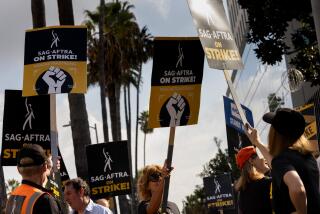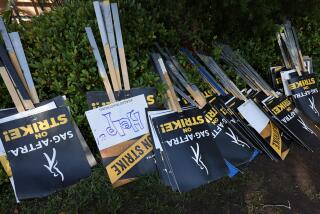Actors Hope to Turn Tide of Strike With P&G; Boycott
With their proposed consumer boycott of Procter & Gamble, striking actors are betting that Hollywood star power will be strong enough to convince consumers to forego such household favorites as Tide, Folgers and Charmin.
The Screen Actors Guild and the American Federation of Television and Radio Artists announced the planned boycott earlier this week as negotiations with national advertisers foundered. Early next week the unions are expected to say which products would be boycotted.
P&G;, the nation’s second-largest advertiser, maintains it won’t bow to SAG demands that it stop using nonunion actors in new commercials. “In the long run, it would be much more harmful to Procter & Gamble if we signed a contract with the actor’s union that would increase our cost of business tremendously,” P&G; spokeswoman Gretchen Briscoe said.
Actors will be getting in line with a diverse group of activists already promoting boycotts. The AFL-CIO is staging 19 separate boycotts, ranging from a small furniture manufacturer to Wells Fargo Bank. Co-op America, a Washington, D.C.-based public interest group, lists nearly two dozen additional actions involving corporations and government bodies.
Boycotts can produce results, particularly when they involve social causes. Nike Inc. modified overseas production practices after public protests, and P&G; recently backed away from the controversial “Dr. Laura” television show because of a threatened boycott.
“Corporations like P&G; are very concerned about public image and reputation, so if SAG is successful in drumming up enough publicity, they could have something,” said Kent Wong, director of the UCLA Center for Labor Research. “But a union-sponsored boycott is very difficult to launch and very difficult to sustain. It’s not something to be done lightly.”
The use of famous faces to deliver the boycott message clearly is designed to appeal to a celebrity-conscious society. “The only real bargaining power, such as it is, that SAG/AFTRA have is to bring out the big guns,” said Stuart Fischoff, a professor of media psychology at Cal State Los Angeles. “If they can get the major stars out there, people will at least listen to their message. Whether or not they’ll be sympathetic or receptive is another issue.”
Turning on the star power, though, could backfire on the unions.
“If I’m a post office worker in Iowa, this isn’t anything I want to hear about,” said USC marketing professor Michael Kamins. “Even though 98% of these actors don’t make much money, people are going to hear stars saying ‘I need your help because I don’t make enough money.’ That won’t play well anywhere outside of Southern California.”
To succeed, actors must convince busy Americans to listen to a complex debate that’s of interest to a narrow population and then choose sides. “Right now, sympathies aren’t with the actors or the advertisers,” Fischoff said. “And, the unions don’t have a message that’s going to engender much sympathy.”
Striking actors hope to announce next week that 13 million members of the AFL-CIO will join the boycott. But boycotts can be difficult to maintain even with strong support from unions. “For this boycott to be successful, actors will have to build it as broadly as possible by getting as much attention as possible,” Wong said.
Consumer boycotts often take time to generate results. Workers at the Farmer John’s pork products plant in Vernon, for example, credit a two-year consumer boycott with helping to secure a new contract in 1998. The Gallo wines contract signed early this month by the United Farm Workers has links to the nationwide consumer grape boycott started 25 years ago.
Actors also will be asking consumers to change buying patterns formed through repeated exposure to P&G; commercials that, in most cases, featured SAG and AFTRA members. “I don’t know if their message is enough to get a person to stop buying Tide, if that’s what they, their parents and grandparents have been buying,” Fischoff said.
Strikers believe that P&G; is vulnerable to the economic impact of a successful boycott because the Cincinnati-based company has stumbled in recent quarters. Managers are under intense pressure to deliver improved profits. And, observers say, from a practical standpoint, it’s easier to ask consumers to forego a box of Tide than a Buick Regal.
P&G; maintains that it is still a consumer products leader. “Building brands is and long has been a core Procter & Gamble strength,” P&G; President and Chief Executive A.G. Lafley said during a Thursday conference call with Wall Street analysts. Striking actors are going up against some of the most powerful advertisers in the world.
Ten of P&G;’s brands boast sales of more than $1 billion, and the company owns the market leader in 21 consumer goods categories. SAG and AFTRA also are targeting General Motors Corp. and AT&T; Corp., which continue to produce commercials with nonunion actors. GM was the nation’s single largest advertiser in 1999, with a $4.04-billion budget, according to Advertising Age magazine. P&G; ranked second, with $2.61 billion, while AT&T; finished in fifth place with $1.95 billion.
*
Times staff writer James Bates contributed to this report.
(BEGIN TEXT OF INFOBOX / INFOGRAPHIC)
Top Advertisers
SAG and AFTRA have targeted boycotts at three of the biggest U.S. advertisers. Among them is General Motors, which set a U.S. record in 1999 by spending $4.04 billion on advertising and marketing. The top five U.S. advertisers, based on ad spending:
*--*
Company 1999 1998 % change General Motors $4.04 3.01 +34.2% Procter & Gamble $2.61 2.67 -2.2% Philip Morris Cos. $2.10 2.05 +7.4% Pfizer $2.14 1.81 +17.8% AT&T; Corp. $1.95 1.50 +29.3%
*--*
Source: Advertising Age magazine
(BEGIN TEXT OF INFOBOX / INFOGRAPHIC)
Some Corporations Targeted by Boycotts
*--*
Target Organizer Allegation/reason BP Amoco San Juan Citizens Mining operation tainting Alliance Colorado groundwater Anheuser-Busch American Reform Party Rejects AB’s sponsorship of Commission on Presidential Debates Boise Cascade American Lands Protesting old-growth forest logging Burlington Coalition to Abolish Protests sale of fur coats Coat Factory the Fur Trade Gap Inc. Save the Redwoods/ Alleges that Gap owners are Boycott the Gap clear-cutting on land in Mendocino, Calif. Hormel Austin United Support Unfair labor practices Group Levi Strauss Fuerza Unida Unfair labor practices & Co. Mt. Olive Farm Labor Organizing Unfair labor practices Pickles Co. Committee Neiman Marcus Coalition to Abolish Protests sale of fur coats the Fur Trade
*--*
Source: Co-op America
More to Read
The biggest entertainment stories
Get our big stories about Hollywood, film, television, music, arts, culture and more right in your inbox as soon as they publish.
You may occasionally receive promotional content from the Los Angeles Times.










